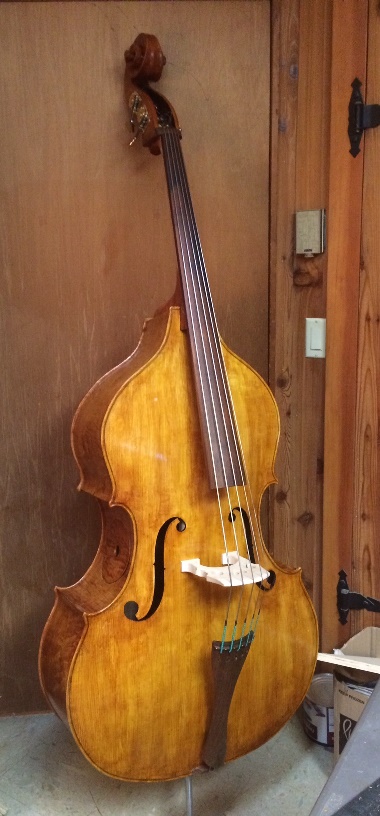Extension or No Extension?
Five-string double basses are the alternative to adding a C-extension, or a B-extension, to a standard double bass. You can reach those floor-shaking deep bass notes on an instrument that will still fit in a bag or a travel-case. It also is less fragile and less unwieldy. But of course, such things are matters of choice. Having choices is something that most people like. So, I can put an extension on a regular bass, or I can build a five-string double bass; and I will acheive the same goal with less trouble.
(By the way: did you ever wonder why the double bass is called a “double” bass? In French, the old word for a violoncello is “un basse”. Today, the double bass is called “contrabasse” in French, but the old name was simply that it was “twice as low,” hence, a “double basse”.)
Not many luthiers are even willing to build a bass: they are a huge project, and take a great deal of time, effort and money. None of my teachers ever built one at all. But I found a book by Peter Chandler, called “So, You Want to Make a Double Bass.” It had nearly all the information I needed to build the bass, but not a great deal about set-up. I bought another book by Chuck Traeger which explained more about set-up, called “Setup And Repair of the Double Bass for Optimum Sound.”
Building My First Bass
From the beginning, I saw inside the front page of Mr. Chandler’s book a photograph of all the raw materials for a bass. He used these specific materials to build the bass shown in the book. The stack weighed 115 pounds. The finished bass weighed 20 pounds. So he had to carve away 95 pounds of waste wood, to make that bass!
No wonder luthiers balk at building a bass! Also, if one is limited for shop-space (and I am) then the bass monopolizes the entire shop while it is in progress. I followed Mr. Chandler’s instructions and built my first bass, modeled after an instrument by Willian Tarr.
But! Having built one, I developed a hankering to build another! I bought wood, tuning machines, and a fingerboard, etc., and began another bass, of my own design. Unfortunately, I had enough other demands on my time (for smaller instruments as well as just ordinary family responsibilities) that the “start” was as far as I got, for quite a while. For three years, the new bass silently sneered at me from the corner of my shop, whenever I looked at it.
Building the Five-String Bass
But I did go back and finish it, and, I changed course, very slightly: it now boasts five-strings, with a low B-string (thus, no extension needed.) (See the featured photos, above and below.) The fingerboard is Ipé, as is the tailpiece.
It also features a removable neck for easy, safe transport. A side access port provides easy access to a single bolt for disassembly or reassembly. Inevitably, since the soundpost is very likely to move during travel, the side port also provides quick and easy re-adjustment of the soundpost.
Five String Double Basses For Sale:
See the Chronology page for available instruments, or call for a quote on a commission.


